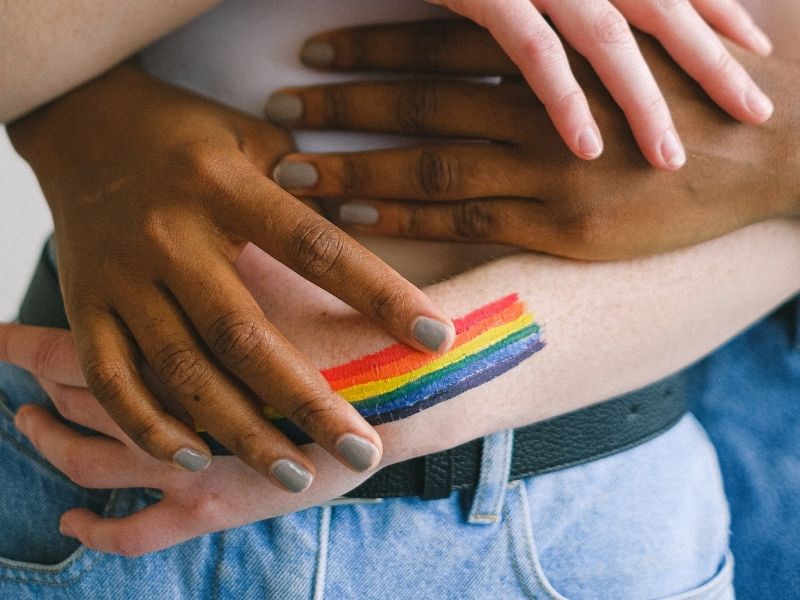How to Support LGBTQ+ Friends or Family Members

Having a friend or family member come out to you as a part of the LGBTQIA+ community is one of the most privileged experiences you can have. They have chosen you as a safe person that they feel comfortable sharing a deep, intimate part of themselves with. Even if you’re not sure what to say, the best way to support LGBTQ+ people in this vulnerable moment is by thanking them deeply for sharing this truth about themselves with you.
Although conversations around LGBTQ+ identities are at an all-time high, people in this community still face legal, social, medical, familial, and professional discrimination. Because of this, the choice to come out is no light matter. A lot of thought likely went into their decision to confide in you.
The first step after this conversation is self-education. This article is a great starting point and will lead you to more specific resources to help you support the people you love. The coming-out conversation is only just the beginning.
The Initial Conversation
If you have the impression that someone is trying to start the conversation about their sexual orientation or gender identity, make them feel as comfortable as possible. Let them know that you are always available to talk and you’re there to listen, no matter what they have to say. Ask them if there’s something on their mind. They might be looking for an invitation or an opportunity to start the conversation. If they say there’s nothing on their mind, don’t push them. Let them do this in their own time, as they will decide when it’s right to discuss LGBTQ+ identities with you.
Once the conversation starts, you need to be all ears. Do not interrupt them; let them say whatever they’re thinking, whatever they’ve rehearsed. Once they’ve finished, the very first words out of your mouth need to be ones of unwavering support. Emphasize how your love will always be unconditional. If they’re someone who enjoys physical affection, give them a big hug.
The very first few moments after they come out to you will be ingrained in their mind for the rest of their lives and will likely inform your relationship moving forward. Show them without a doubt that you are there for them and that you are a safe person to come to in the future, whether it be about matters of sexual orientation and gender identity or any other topic they need to talk about.
If you shut them down or center the conversation on yourself, you can be sure that they will not share personal details or experiences with you in the future. If you want to be a part of their lives moving forward, show that you are absolutely someone they can trust and feel safe with. It makes a huge difference in an LGBTQ+ youth’s life when they have supportive parents and family to rely on.
Follow-Up Research
Once you’ve had the initial conversation, it’s time to do your research. While you can ask questions about their personal experience, it is not their job to educate you on their identity and what is and is not problematic to say. There are a vast number of resources available online, and here are some great places to start:
- CDC Resources: This page has a variety of cultivated resources for friends and family of LGBT+ people.
- The ABCs of LGBTQIA+: This NYT article gives a starter glossary of common terms used to describe genders and sexualities.
- GLAAD LGBTQ+ Resources: This set of resources has a variety of categories, ranging from bisexual to military.
Many places offer services to lesbian, gay, bisexual, transgender, and questioning/queer (LGBTQ) people. If one of your friends needs assistance because they were rejected by their family or are struggling, check out these resources:
- GLBT Near Me: This is an active database to find local resources under a variety of categories.
- The Trevor Project: This organization offers mental health resources, crisis intervention, and suicide prevention for people in the LGBTQ+ community. They have support groups and a hotline to call if your friend is contemplating suicide.
- True Colors United: LGBTQ+ youth are 120% more likely to experience homelessness than their cis/heterosexual counterparts. This organization offers advocacy, education, and services to change that statistic for young people.
Life-Long Commitment
Coming out is not a one-time conversation. Because identity and orientation are fluid, they’ll likely continue to learn new things about themselves as they grow, and they will share these discoveries with you in time. Every time they share something new with you, thank them for this trust and take any requests to heart. Continue to offer an actively supportive environment. If someone asks to be referred to by their chosen name or new pronouns, fiercely respect this development.
Ask if others know about this development; sometimes, someone will continue to use their assigned-at-birth pronouns or deadname around people they aren’t comfortable coming out to quite yet. If they ask you to only use their true name and pronouns when you’re alone, respect this, and if they say it’s now public knowledge, correct people when they misgender them or refer to them by their deadname. They will have to continually correct people, and it’s a huge help when other people stand up for them both when they’re there and when they’re not around. Family members won’t get used to their new pronouns if they are the only ones enforcing them. Don’t let family members get away with using the incorrect pronouns when they’re not around.
If someone has discovered that their gender identity does not match with what they’re assigned at birth, they might change up their look to affirm themselves and feel more comfortable. You can compliment these adjustments (I like your skirt/that haircut really suits you), but don’t make comments like “you look different” or “this is new.” These comments probably will not be seen as affirming and supportive. If they blush when you offer compliments, refrain from commenting in the future. Take direction from their reactions and requests.
And on the other hand, if the non-binary or trans person does not change their outward appearance, that does not invalidate their identity. They do not have to dress as their true gender to “prove” who they are.
Support LGBTQ+ Communities
In 2020, more trans women were murdered than any other year.
Youth in the LGBTQ+ community are 3.5 more likely to attempt suicide than their heterosexual counterparts, and trans youth were 5.87 time more likely.
More transphobic laws have been passed in 2021 than any other year, and the year isn’t even close to over.
It’s scary to be a part of the LGBTQIA+ community.
But you can play a significant role in protecting the people you love; youth in the LGBTQ+ community that have at least one adult who actively accepts them were reportedly 40% less likely to attempt suicide in the past year.
It’s amazing how much power family members and friends have to support LGBTQ+ loved ones.
Author, Artist, Photographer.
Sarah Margaret is an artist who expresses her love for feminism, equality, and justice through a variety of mediums: photography, filmmaking, poetry, illustration, song, acting, and of course, writing.
She owns Still Poetry Photography, a company that showcases her passion for capturing poetic moments in time. Instead of poetry in motion, she captures visual poetry in fractions of a second, making cherished keepsakes of unforgettable moments.
She is the artist behind the Still Poetry Etsy shop, which houses her illustrations and bespoke, handmade items. She is the author of intricacies are just cracks in the wall, a narrative poetry anthology that follows a young woman discovering herself as she emerges from an abusive relationship.






Responses